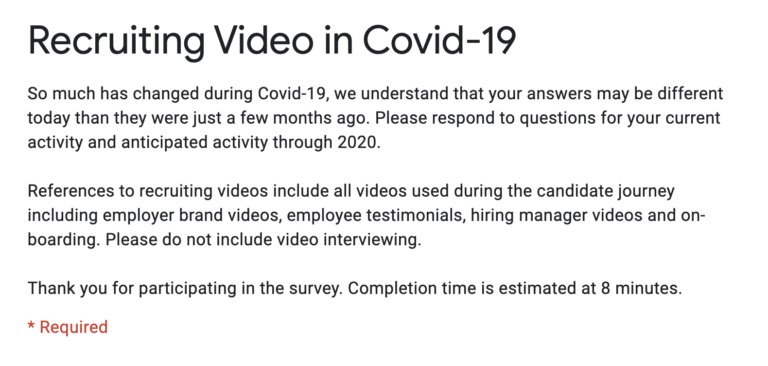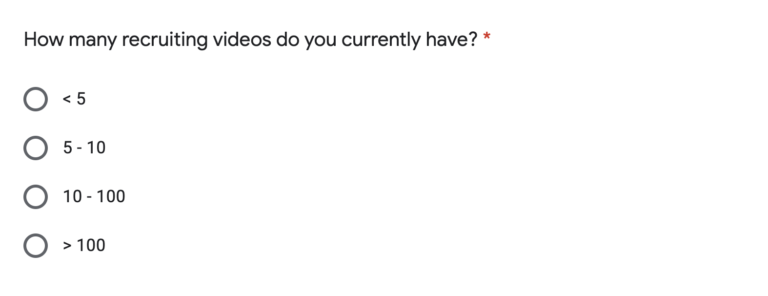Ekaterina Galieva
8-20-2020
Survey Results
Contents:
EXECUTIVE SUMMARY
METHODOLOGY
HIRING STATUS OF RESPONDENTS
Number of Hires
The Size of the Recruiting Teams
Size of Recruiting Budget
Recruiters Doing More with Less
FINDINGS
- Video is being used to humanize the recruiting process.
- Companies are producing multiple videos and building video libraries.
- Video content is expanding beyond employee testimonials and day-in-the-life.
- Distribution outlets for videos align with candidate information sources.
- Video production is overwhelmingly created by internal resources.
- Having a video library strengthens the recruiting process.
- Videos that the candidate can relate to personally have the most impact on recruiting.
- Adoption of video management tools lags expansion of video creation and distribution.
- Time and money are the largest barriers to expanding video use.
EXECUTIVE SUMMARY
Despite two thirds of the survey respondents reporting a decline in hiring since the start of Covid-19, video is being used extensively to humanize the recruiting process. Many respondents indicated new or expanded use of video due to Covid-19.
Key findings of the survey are:
- Video is being used to humanize the recruiting process. Most respondents are using videos to convey corporate culture and work environment.
- Companies are producing multiple videos and building video libraries. More than 50% of respondents have more than 5 recruiting video and 4% of respondents have more than 100 recruiting videos.
- Video content is expanding beyond employee testimonials and day-in-the-life. Content is being created for every stage of the candidate journey.
- Distribution outlets for videos align with candidate information sources. Videos are not confined to career websites and videos are being shared in outlets that match the candidates’ information sources for their current stage of the candidate journey.
- Video production is overwhelming created by internal resources. Most video is not created by professional video companies and is being produced by in-house marketing or employee generated.
- Videos strengthen the recruiting process by creating greater efficiency. Respondents with significant video libraries were able to see and measure the results.
- Videos that the candidate can relate to have the greatest impact on results. Respondents indicated that the most impactful videos were employee testimonials, hiring manager messages and location tours.
- Adoption of video management tools lags adoption of video creation and distribution. Both general video management tools and those designed for Talent Acquisition had low recognition and low adoption.
- Time and money are the largest barriers to expanding a video strategy. Management recognizes the power of video and supports expanded use but resources continue to be a constraint.
METHODOLOGY
The research was conducted between July 16 and July 30, 2020. The survey was distributed via email to approximately 7,100 Talent Acquisition practitioners, was posted in the SourceCon Facebook group, and was posted in social media posts of individuals in the Talent Acquisition field.
The survey was administered using Google forms. All data was collected anonymously but individuals had the option to include contact information in order to receive a copy of the results. Completed surveys were received from 205 individuals. Contact information was included on 170 surveys representing primarily large enterprise employers.
The survey was 14 questions with a combination of closed-ended and open-ended questions. The survey is attached as Appendix A. In the survey introduction, respondents were asked to respond to questions about their use of video in recruiting but to exclude video interviewing.
Most questions allowed respondents to select multiple answers, so percent responses do not total 100.
Several respondents who identified themselves were asked for permission to use an open-ended response with attribution. All identified quotes are presented with explicit permission.
HIRING STATUS OF RESPONDENTS
Number of Hires
The economic impact of Covid-19 on hiring is well documented in government statics and major news publications. Survey respondents reflected this general decrease in hiring with 68% of respondents reporting a reduction in hiring: modest decrease (38%), dramatic decrease (24%) or frozen (6%).
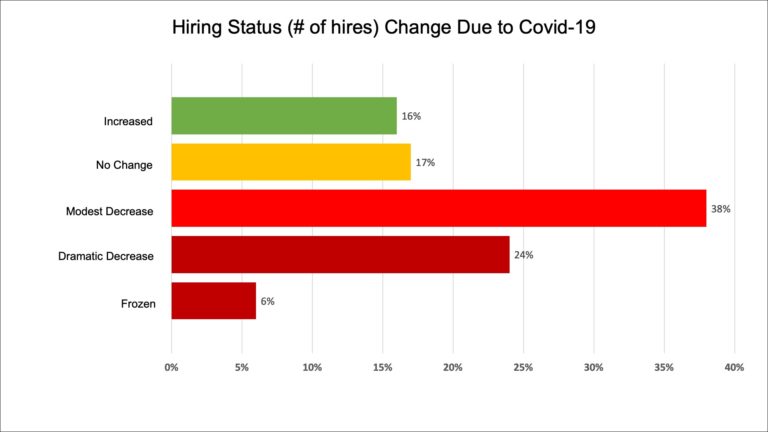 The Size of the Recruiting Teams
The Size of the Recruiting Teams
The size of the recruiting teams was also negatively impacted with 35% reporting a reduction: modest (23%), dramatic (10%) or frozen (2%). This result is undoubtedly understated based on the approximately 1,500 undeliverable emails from the initial survey invitations (25%). Companies that laid off their entire recruiting departments, such as American Airlines, are not represented in this survey.
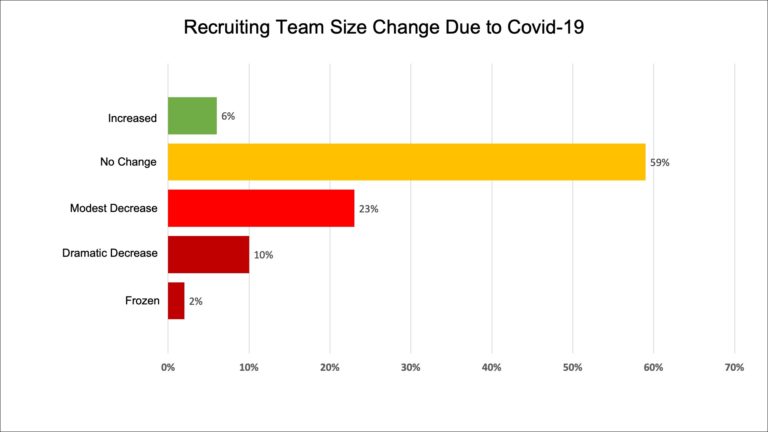 Size of Recruiting Budget
Size of Recruiting Budget
Not surprisingly, recruiting budgets also declined. Budgets were likely to decline proportionate to the decline in the number of hires (modest decrease in hires 38% – modest decrease in budget 36%; dramatic decrease in hires 24% – dramatic decrease in budget 15%; frozen hires 6% – frozen budget 7%).
 Recruiters Doing More with Less
Recruiters Doing More with Less
While 16% of respondents increased the number of hires, only 5% increased the size of their recruiting team and only 3% increased their recruiting budget. Thirteen percent of the respondents were asked to increase the number of hires with no additional financial resources.
Conversely, of the 30% that dramatically decreased or froze hiring, 12% reduced the size of their recruiting team and the majority, 22%, dramatically decreased or froze their recruiting budget.
Companies are more apt to cut resources to recruiting during a downturn than they are willing to fund recruiting during an increase.
FINDINGS
1. Video is being used to humanize the recruiting process.
Only 24% of respondents did not use video in some way to humanize the recruiting process. Most respondents reported using video to convey culture and work environment (51%) or cited video interviews (34%) among other methods.
 2. Companies are producing multiple videos and building video libraries.
2. Companies are producing multiple videos and building video libraries.
While many employers have not produced an extensive library of recruiting videos, 53% have more than 5 videos and as subsequent answers in this survey showed, have expanded beyond the general recruiting videos that appear on company websites. Almost 5% of respondents have more than 100 videos. Many respondents commented that they were planning on producing more videos.
 3. Video content is expanding beyond employee testimonials and day-in-the-life.
3. Video content is expanding beyond employee testimonials and day-in-the-life.
Video is being used throughout the recruiting process. Companies are creating a variety of videos for specific purposes rather than large libraries of similar content. Many respondents reported use of one-time personalized videos intended for a single audience member.
Respondents reported creating and using video for:
- hiring manager introductions to applicants
- intern documentaries of their internship experience
- leaders showcasing departments
- introductions to virtual hiring events
- discussion of candidate FAQs
- hiring manager discussions of qualities desired in a candidate
- individualized 30-second pitches to passive candidates
- “meet our team” introductions
- VR tour of offices
- explanation of interview process
- showcasing safe culture and commitment to employee safety
- intros and outros to video interview
- day-in-the life of a product to showcase distribution centers
- instructions and “Help sections” as part of the application to improve accuracy
- custom video from team welcoming new employee
- on-boarding instructions
- welcome messages to new employees, birthday wishes, thank you videos
- videos through stages of the compliance and background check
- immediate supervisor and team welcome video sent with offer letter
Interestingly, respondents who reported using customized and personal video messages often indicated that their total recruiting videos were fewer than 10. This data inconsistency indicates that TA leaders compartmentalize their videos and do not necessarily think of all video communication as “recruiting videos.” Use of video in the recruitment process may be grossly understated by this survey.
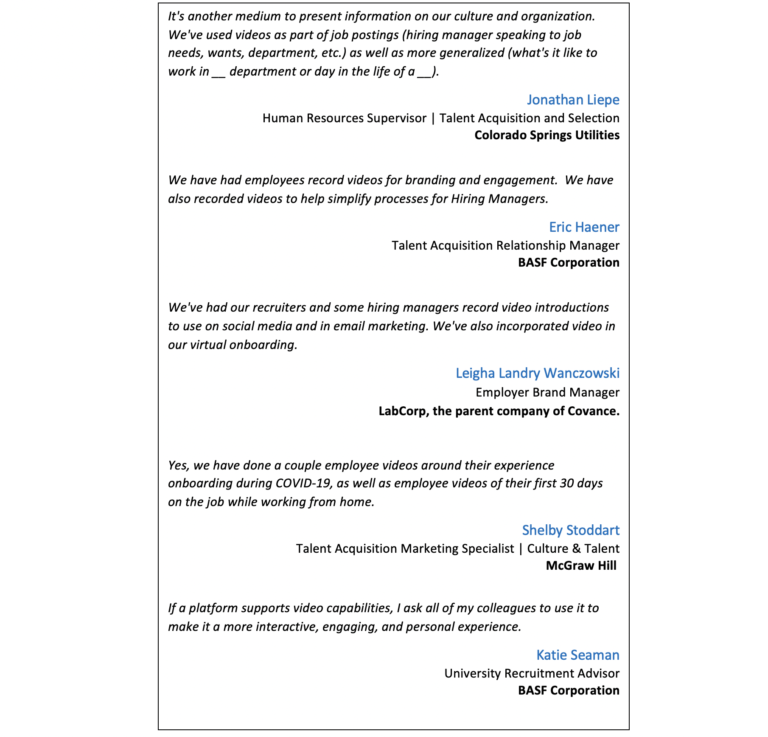 4. Distribution outlets for videos align with candidate information sources.
4. Distribution outlets for videos align with candidate information sources.
Video is being used to some extent in every phase of the candidate journey and the distribution of the videos changes to align with the candidates’ information sources at each stage. When video is used for attraction (88%), the primary distribution channels are social media (82%), career site (81%) and YouTube (59%). The next most common use of video is onboarding (66%) and videos are most commonly distributed via private hosting (68%) (Microsoft Teams, Slack, etc.) and email (45%). When video is used for nurturing (62%), the primary distribution channels are social media (64%), career site (57%) and email (54%).
Not surprisingly, when respondents created more than 10 videos, they generally created videos for more stages of the candidate journey rather than more videos with similar content such as employee testimonials or day-in the-life. Respondents with less than 10 videos were generally restricted to the attraction stage.
 5. Video production is overwhelmingly created by internal resources.
5. Video production is overwhelmingly created by internal resources.
Given the predominance of large corporations among the respondents and corporations’ traditional preference for high quality and polished marketing materials, it would be reasonable to assume that most videos were produced by professional production companies. The data shows, however, that in-house marketing teams and employee generated videos are the primary production methods. Many organizations used multiple sources to create their videos but 18% used exclusively self-produced videos with no use of external resources.
In-house marketing was the most common resource used to produce videos. Sixty-five percent of respondents produced at least one video with in-house marketing. Of the respondents who used in-house marketing, 81% produced 10 or fewer videos. Surprisingly, 7 respondents (5% of companies using in-house marketing) produced more than 25 videos internally. Qualitative responses indicated that access to marketing resources was new or recently increased.
Employee generated video was used by 61% of respondents with 36% of those respondents creating more than 10 videos each. In addition to employee generated video, 36% of respondents used informal production, which based on open-ended responses, means recruiters or other non-video professionals recording video on phones, computers or hand-held cameras.
External resources were used by a minority of respondents during the last twelve months to produce recruiting videos. Only 20% of respondents produced video with an advertising agency and only 32% used an independent production company.
Note: Because this survey is a snapshot in time and not longitudinal, it is not possible to conclude if companies are becoming more comfortable with less professional production values; or if they only update professionally produced videos every several years (the survey only asked about production in the past 12 months); or if Covid restrictions reduced the ability to create professional produced video.
 6. Having a video library strengthens the recruiting process.
6. Having a video library strengthens the recruiting process.
Noticeable, and sometimes measurable impact of videos on recruiting was reported by 68% of the respondents. Comments generally referred to three impacts: increased efficiency (38%), humanized recruiting (18%), and provided education on culture and brand (17%). Respondents who had less than 10 recruiting videos were less likely to observe any value.
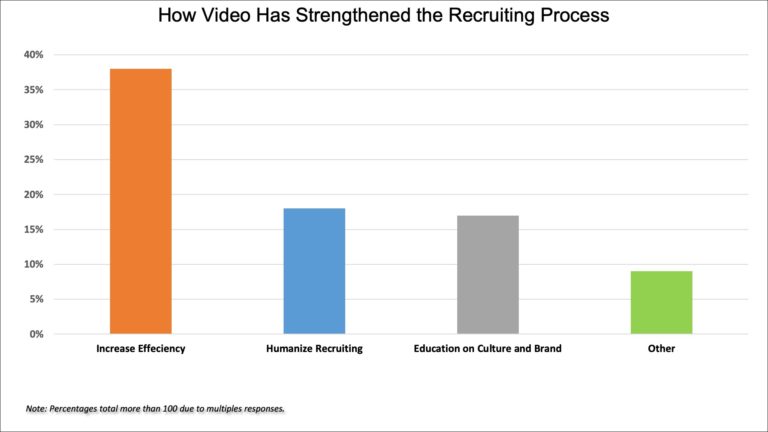
 7. Videos that the candidate can relate to personally have the most impact on recruiting.
7. Videos that the candidate can relate to personally have the most impact on recruiting.
Whether or not they currently used video in each capacity, respondents anticipated that the type of video with the greatest impact on recruiting results are videos that relate to the individual rather than company information. Employee testimonials were almost universally considered powerful in influencing candidates (90%), followed by a message from the hiring manager (61%) and a tour of the location where the candidate would work (58%). Career advancement perspective was also rated highly (51%).
 8. Adoption of video management tools lags expansion of video creation and distribution.
8. Adoption of video management tools lags expansion of video creation and distribution.
Despite half of respondents having more than 5 recruiting videos, and potentially large numbers of one-time use videos and other informational videos, few were using any video management software (22%) and only 11% were using a tool designed for TA (Amplify VMS, SparcStart, VideoMyJob and Altru). Not only was adoption low, but few respondents had investigated tools and were overwhelmingly unfamiliar with general video management tools and the tools designed specifically for TA.
 9. Time and money are the largest barriers to expanding video use.
9. Time and money are the largest barriers to expanding video use.
While a small number of respondents noted the logistical difficulties of Covid19 in creating video content (7%), the overwhelming response was lack of resources (39%), specifically budget and time. With the low adoption of video management systems, it was not surprising that technology (10%) was the next largest barrier to expanding the video strategy. Several respondents noted the reluctance of some employees to participate in video (8%) and the obstacles presented by the Marketing and Legal departments (8%). Almost one quarter of respondents saw no barriers (23%) which is consistent with verbatim responses that indicated current, or anticipated, video creation.
 CONCLUSION
CONCLUSION
Video has tremendous potential to humanize the recruiting process and a number of companies are using the medium extensively. Companies with large video libraries are inserting videos into each stage of the candidate journey and seeing results. The need to generate sufficient content appears to necessitate in-house and employee-generated creation. Adoption of video platforms lags video use at least partially explaining the barriers cited to expanding a video strategy. With few exceptions, the power of video is accepted by TA leaders and company management, and adoption is moving quickly.
ABOUT THE AUTHOR
I am Ekaterina Galieva, a 2019 graduate of Duke University’s Fuqua School of Business. I also have an undergraduate Economics degree and masters in Economics and Finance from Lomonosov Moscow State University. During my time at Duke’s MBA I earned Management Science and Technology Management certificate. I had an amazing experience at Fuqua and I was really impressed how many companies are flying to the campus to present the career opportunities they offer to their employees. I had a chance to talk to professionals who work for these companies, learn about their experiences, and career paths. It was a great opportunity to see if I can be a good fit to a company by talking to its employees. Company visit and personal meetings are an essential detail in communication between a company and its potential candidates. I was really interested to see how companies are going to transmit the corporate culture to their potential candidates and how can office hours and face to face meetings could be substituted during and after the Covid-19. So, as a part of my post-MBA training program, I decided to launch the marketing research survey to see how companies are employing technology in such areas where technology was traditionally not a commonly used instrument.
Appendix A
